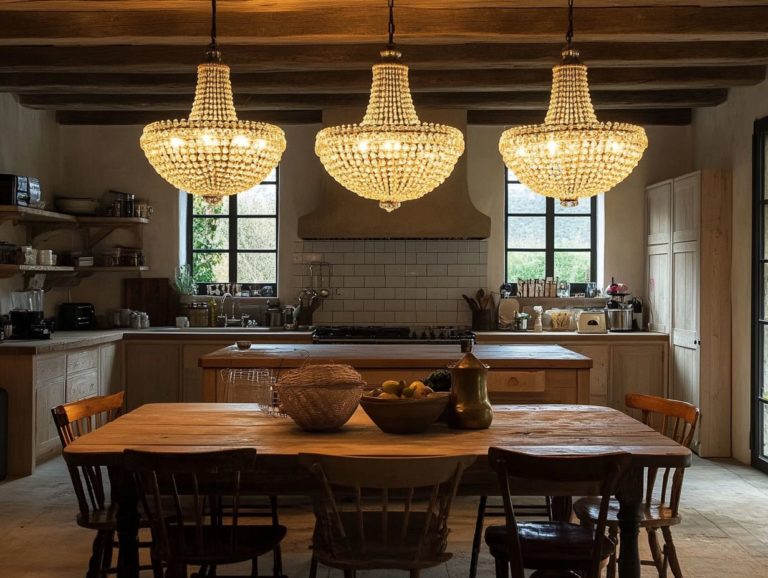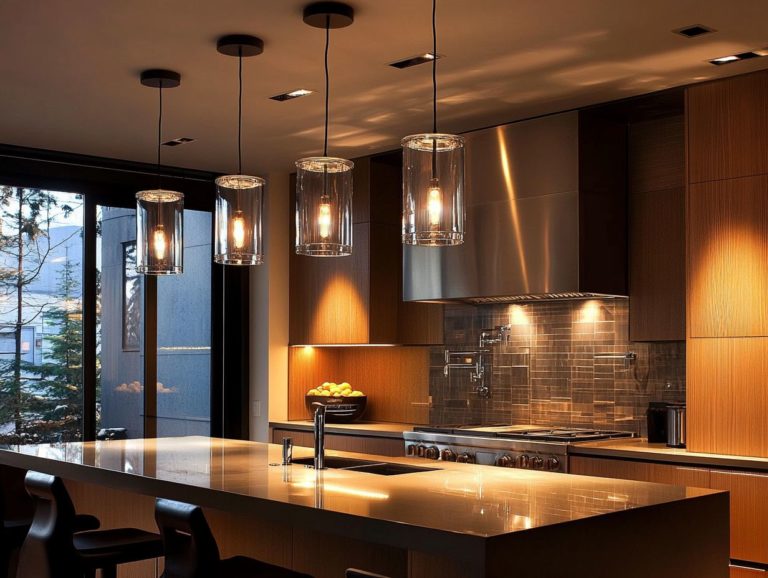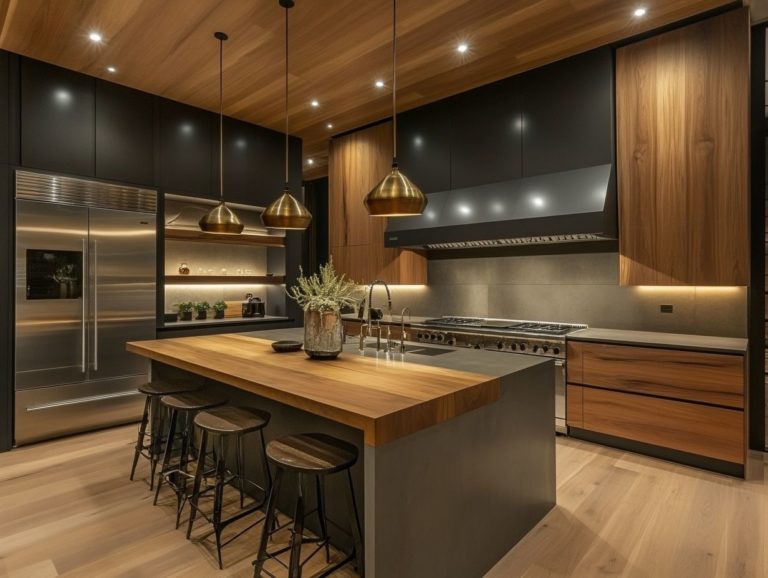Understanding the Basics of Kitchen Lighting Design
Creating the perfect kitchen involves more than just selecting the right appliances and decor. Effective lighting design is crucial for enhancing both functionality and aesthetics.
From illuminating workspaces for meal preparation to crafting the perfect ambiance for family gatherings, kitchen lighting has the power to transform the heart of your home.
This article delves into various types of lighting—task, ambient, and accent—while considering essential factors such as layout, color schemes, and energy-saving options.
You’ll discover practical tips for maximizing natural light and choosing fixtures that elevate your kitchen experience.
Whether you’re embarking on a renovation or simply refreshing your space, a solid understanding of kitchen lighting design is essential.
Contents
Key Takeaways:

Understanding kitchen lighting basics is vital for a functional and attractive space.
Consider task, ambient, and accent lighting for a well-rounded design.
Account for layout, color scheme, and energy-saving options in your design.
The Importance of Kitchen Lighting Design
Kitchen lighting design holds immense importance for both functionality and aesthetics. It shapes the ambiance and usability of one of the most vital spaces in your home.
The right lighting strikes a harmonious balance between ambient, task, and accent lighting. This ensures that every nook of your kitchen is well-illuminated while elevating the overall interior design.
Effective lighting controls, like dimmers and LED lights, are often prioritized to foster an inviting atmosphere. They make lighting an essential aspect of any home renovation project.
Enhancing Functionality and Aesthetics
Enhancing functionality and aesthetics in your kitchen is all about thoughtful lighting design. This design artfully blends different styles, including ambient, task, and accent lighting.
By integrating these elements, you create a space that feels both inviting and highly efficient for meal preparation and entertaining.
For example, under-cabinet lighting does double duty by illuminating your countertops for cooking while casting a warm glow that enriches the overall ambiance.
Pendant lights above your island can serve as stunning focal points, drawing the eye and infusing character into your kitchen.
When you combine these fixtures, you’re not just illuminating a room; you’re transforming a mundane space into a beautifully lit area that enhances usability and beckons gatherings. This truly makes it the heart of your home.
Types of Lighting for Kitchens
Grasping the different types of kitchen lighting is essential for crafting a lighting design that seamlessly balances functionality and style.
By thoughtfully integrating ambient, task, and accent lighting into your kitchen space, you can elevate both its practicality and aesthetic appeal.
Task Lighting
Task lighting is crucial in your kitchen as it focuses on illuminating specific work areas. This enhances functionality for cooking, preparation, and other culinary tasks.
By strategically placing fixtures like under-cabinet lighting, you ensure your countertops are brilliantly lit. This makes it easy to chop vegetables or read recipes without straining your eyes.
Pendant lights suspended over your island offer direct illumination where you need it most. They facilitate safe food handling while also elevating the overall aesthetic of the space.
When executed properly, task lighting boosts your efficiency during meal preparations. It also enhances safety by reducing shadows and brightening those often-overlooked dark corners.
This thoughtful approach creates a more inviting and productive environment for anyone eager to whip up culinary delights.
Transform your kitchen with the right lighting!
Ambient Lighting

Ambient lighting forms the essential foundation of your kitchen illumination, crafting a comfortable and inviting atmosphere that floods the space with overall light.
You can achieve this type of lighting through various options, such as ceiling-mounted fixtures that evenly distribute light or sleek recessed lighting that modernizes your design while saving precious space.
However, relying solely on ambient lighting might leave some areas a bit dim. To ensure a well-rounded design, it’s crucial to integrate additional layers like task and accent lighting.
By thoughtfully combining these elements, you can enhance both the functionality and aesthetic appeal of your kitchen, making sure every corner is practical and visually engaging.
Accent Lighting
Accent lighting is essential in your kitchen design, as it highlights specific features or areas, elevating the overall aesthetic and infusing visual interest.
This specialized lighting not only draws attention to artwork or architectural details—like unique cabinetry or decorative backsplashes—but also complements the existing ambient and task lighting beautifully.
For example, consider positioning track lighting to showcase a stunning piece of artwork above the counter while integrating LED strip lights beneath shelves to cast a warm glow on your decorative dishes.
By blending these accent options with ambient lighting for overall illumination and task lighting for essential kitchen tasks, you can cultivate a balanced and inviting atmosphere that enhances both functionality and style.
Factors to Consider in Kitchen Lighting Design
When you’re designing kitchen lighting, there are several essential factors you should consider to create a space that is both effective and harmonious.
These include the layout, size, color scheme, and overall energy efficiency. Each element plays a vital role in crafting the perfect ambiance for your kitchen.
Layout and Size of the Kitchen
The layout and size of your kitchen play a crucial role in shaping the lighting design, as they dictate the types and placements of fixtures needed for optimal illumination.
In an open-concept kitchen, you’ll find that a blend of pendant lights and recessed fixtures works wonders. This combination creates layers of light that elevate both functionality and ambiance. Position these fixtures strategically over islands and key work areas to ensure every corner shines brightly for meal preparation.
On the other hand, a galley kitchen, with its narrow design, requires more focused lighting solutions. Under-cabinet lights are ideal for effectively illuminating countertops, enhancing visibility without overwhelming the space.
Additionally, considering the dining areas nearby can influence your choice of statement fixtures, which not only provide practical lighting but also serve as striking focal points that unite the whole area.
Color Scheme and Style
The color scheme and style of your kitchen are crucial in determining the most suitable lighting design, ensuring that the overall aesthetic remains cohesive and visually appealing.
When selecting the right lighting, it’s essential to consider how different color palettes interact with light and shape your perception of space. For example, lighter colors reflect more light, making smaller kitchens feel more spacious.
Warm tones, like soft yellows and creams, can foster an inviting atmosphere that beautifully complements rustic and farmhouse styles. Conversely, bold colors, such as deep blues or greens, can evoke a dramatic ambiance, which aligns perfectly with contemporary designs.
To enhance these effects, you can expertly tailor pendant lights or recessed lighting to spotlight specific areas, while under-cabinet lighting offers functional illumination without overpowering the design.
Fixtures like chandeliers can introduce a touch of flair, particularly in transitional spaces that blend traditional and modern elements seamlessly.
Energy Efficiency

Energy efficiency is key in kitchen lighting design. It helps you reduce electricity use while providing great light.
Embracing energy-efficient fixtures, especially LED lights, is now essential. These lights use up to 75% less energy than traditional bulbs and last much longer.
By choosing LED fixtures, you’re helping the environment and cutting down your carbon footprint.
Today’s trends focus on sleek designs that are both functional and stylish. Your energy-efficient lighting can boost both the look and productivity of your kitchen.
Tips for Designing Effective Kitchen Lighting
To create effective kitchen lighting, consider placement carefully. Choose fixtures that enhance your space and welcome in natural light.
This thoughtful design creates a balanced, functional area that looks good and is practical.
Placement and Direction of Lights
The placement and direction of lights are crucial in your kitchen. They affect both visibility and the atmosphere.
When lights are strategically placed, they transform work areas into inviting spots for cooking and socializing.
Good kitchen designs include layers of lighting types to improve usability and set the mood. These include general lighting for overall brightness and task lighting for workspaces.
Using adjustable recessed lights or under-cabinet fixtures in work areas keeps them bright. Meanwhile, softer lights in dining areas create a cozy feel.
Properly angling your lights eliminates shadows, making everyday tasks easier. This ensures every corner of your kitchen shines.
Choosing the Right Light Fixtures
Picking the right light fixtures involves balancing style and functionality. Each fixture should fit your kitchen’s design and lighting needs.
Consider size, style, and energy efficiency when making your choice. An oversized pendant light can be a stunning focal point, while smaller recessed lights offer a sleek appearance.
Choosing energy-efficient fixtures, especially LEDs, helps you save on utility bills. Popular options include industrial-style sconces or modern chandeliers that enhance various design styles.
Utilizing Natural Light
Natural light is vital in kitchen design. It creates a bright atmosphere and reduces the need for artificial lighting.
Positioning windows wisely invites sunlight into your kitchen. South-facing windows are best for capturing light throughout the day.
Use reflective surfaces like glossy cabinets to maximize natural light and brighten your space. Combining these elements with well-placed artificial lighting creates a harmonious environment.
This thoughtful blend not only boosts usability but also improves energy efficiency, making your kitchen welcoming from morning to night.
Frequently Asked Questions

What is kitchen lighting design?
Kitchen lighting design involves planning and selecting lighting fixtures, their placement, and control systems for your kitchen. It aims to create a well-lit, comfortable space for cooking, dining, and other activities.
Why is understanding kitchen lighting important?
Knowing kitchen lighting basics can significantly affect the kitchen’s functionality and atmosphere. Good lighting makes cooking and cleaning easier and enhances the overall visual appeal.
Key elements of kitchen lighting design
Key elements include task lighting, ambient lighting, and accent lighting. Task lighting focuses on specific activities, while ambient lighting provides general illumination. Accent lighting highlights special areas or objects.
Common types of kitchen lighting fixtures
Common fixtures include recessed lights, pendants, track lighting, under-cabinet lights, and chandeliers. Each type serves a unique purpose and contributes to the kitchen’s lighting effect.
How to choose the right lighting for your kitchen
Choosing the right kitchen lighting depends on the space’s size, layout, intended use, and personal preferences. Consulting with a professional designer or electrician can help create the best lighting plan.
Tips for energy-efficient kitchen lighting
To make your kitchen lighting energy-efficient, opt for LED or CFL bulbs over traditional incandescent ones. Install dimmer switches, and consider natural light sources like skylights or large windows.





